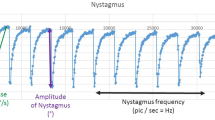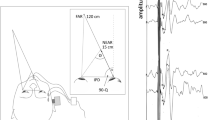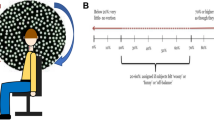Abstract
Acoustic stimulation of the vestibular system has been well documented in humans and has been accepted as a useful tool to diagnose vestibular disorders. The goal of this study was to establish an awake and behaving primate model that might be useful for investigating the neural mechanisms underlying acoustic activation of the vestibular system. We recorded sound-evoked eye movements in monkeys while they performed ocular motor tasks. In the first part of the study, an acoustic click (1 ms, 99~125 db peak SPL) was delivered to one of the monkeys’ ears while they fixated on visual targets of varying eccentricities and viewing distances. Acoustic clicks were found to evoke well-defined biphasic eye velocity responses. For the movement in the horizontal direction, the first eye velocity peaks were always away from the stimulated ear. For the movement in the vertical direction, however, the directions of the first eye velocity peaks varied from monkey to monkey. This variability was difficult to interpret in the absence of torsional measurement. Thus, our analysis in this report was focused on horizontal eye movements. We found that click-evoked eye movements were disjunctive, with larger first horizontal eye velocity peaks from the eye ipsilateral to the stimulated ear (the amplitude ratio was 1.8±0.3, n=4). The amplitudes of the first horizontal peaks were also linearly correlated with gaze eccentricity and viewing distance. In the second part of the study, we found that a brief tone-pulse (100 ms, 125 db peak SPL) evoked eye movements that exhibited a well-defined frequency tuning with the most effective stimulating frequencies ranging from 1 K to 1.5 KHz. These data demonstrate that the sound-evoked eye movements in behaving monkeys are well defined and reproducible. This paradigm may be useful for studying the neural mechanisms underlying acoustic activation of the vestibular system.




Similar content being viewed by others
References
Angelaki DE, Newlands SD, Dickman JD (2000) Primate translational vestibuloocular reflexes. IV. Changes after unilateral labyrinthectomy. J Neurophysiol 83:3005–3018
Angelaki DE, Green AM, Dickman JD (2001) Differential sensorimotor processing of vestibulo-ocular signals during rotation and translation. J Neurosci 21:3968–3985
Backous DD, Minor LB, Aboujaoude ES, Nager GT (1999) Relationship of the utriculus and sacculus to the stapes footplate: anatomic implications for sound- and/or pressure-induced otolith activation. Ann Otol Rhinol Laryngol 108:548–553
Chen-Huang C, McCrea RA (1999) Effects of viewing distance on the responses of vestibular neurons to combined angular and linear vestibular stimulation. J Neurophysiol 81:2538–2557
Clendaniel RA, Mays LE (1994) Characteristics of antidromically identified oculomotor internuclear neurons during vergence and versional eye movements. J Neurophysiol 71:1111–1127
Colebatch JG, Halmagyi GM, Skuse NF (1994) Myogenic potentials generated by a click-evoked vestibulocollic reflex. J Neurol Neurosurg Psychiatry 57:190–197
Crane BT, Tian J, Wiest G, Demer JL (2003) Initiation of the human heave linear vestibulo-ocular reflex. Exp Brain Res 148:247–255
Fluur E, Mellstrom A (1970a) Utricular stimulation and oculomotor reactions. Laryngoscope 80:1701–1712
Fluur E, Mellstrom A (1970b) Saccular stimulation and oculomotor reactions. Laryngoscope 80:1713–1721
Gamlin PD, Gnadt JW, Mays LE (1989) Abducens internuclear neurons carry an inappropriate signal for ocular convergence. J Neurophysiol 62:70–81
Halmagyi GM, Colebatch JG (1995) Vestibular evoked myogenic potentials in the sternomastoid muscle are not of lateral canal origin. Acta Otolaryngol Suppl 520:1–3
Halmagyi GM, McGarvie LA, Aw ST, Yavor RA, Todd MJ (2003) The click-evoked vestibulo-ocular reflex in superior semicircular canal dehiscence. Neurology 60:1172–1175
Hine T, Thorn F (1987) Compensatory eye movements during active head rotation for near targets: effects of imagination, rapid head oscillation and vergence. Vision Res 27:1639–1657
Judge SJ, Richmond BJ, Chu FC (1980) Implantation of magnetic search coils for measurement of eye position: an improved method. Vision Res 20:535–538
Lasker DM, Ramat S, Carey JP, Minor LB (2002) Vergence-mediated modulation of the human horizontal angular VOR provides evidence of pathway-specific changes in VOR dynamics. Ann N Y Acad Sci 956:324–337
Lisberger SG, Fuchs AF (1978) Role of primate flocculus during rapid behavioral modification of vestibuloocular reflex. I. Purkinje cell activity during visually guided horizontal smooth-pursuit eye movements and passive head rotation. J Neurophysiol 41:733–763
McConville KM, Tomlinson RD, Na EQ (1996) Behavior of eye-movement-related cells in the vestibular nuclei during combined rotational and translational stimuli. J Neurophysiol 76:3136–3148
McCue MP, Guinan JJ (1994) Acoustically responsive fibers in the vestibular nerve of the cat. J Neurosci 14:6058–6070
Medendorp WP, Van Gisbergen JA, Van Pelt S, Gielen CC (2000) Context compensation in the vestibuloocular reflex during active head rotations. J Neurophysiol 84:2904–2917
Minor LB, Solomon D, Zinreich J, Zee DS (1998) Sound- and/or pressure-induced vertigo due to bone dehiscence of the superior semicircular canal. Arch Otolaryngol Head Neck Surg 124:249–258
Murofushi T, Curthoys IS, Topple AN, Colebatch JG, Halmagyi GM (1995) Responses of guinea pig primary vestibular neurons to clicks. Exp Brain Res 103:174–178
Ogawa Y, Kushiro K, Zakir M, Sato H, Uchino Y (2000) Neuronal organization of the utricular macula concerned with innervation of single vestibular neurons in the cat. Neurosci Lett 278:89–92
Paige GD, Tomko DL (1991) Eye movement responses to linear head motion in the squirrel monkey. I. Basic characteristics. J Neurophysiol 65:1170–1182
Ramat S, Zee DS (2003) Ocular motor responses to abrupt interaural head translation in normal humans. J Neurophysiol 90:887–902
Robinson DA (1963) A method of measuring eye movement using a scleral search coil in a magnetic field. IEEE Trans Biomed Eng 10:137–145
Scudder CA, Fuchs AF (1992) Physiological and behavioral identification of vestibular nucleus neurons mediating the horizontal vestibuloocular reflex in trained rhesus monkeys. J Neurophysiol 68:244–264
Snyder LH, King WM (1992) Effect of viewing distance and location of the axis of head rotation on the monkey’s vestibuloocular reflex. I. Eye movement responses. J Neurophysiol 67:861–874
Snyder LH, Lawrence DM, King WM (1996) Behavior and physiology of the macaque vestibulo-ocular reflex response to sudden off-axis rotation: computing eye translation. Brain Res Bull 40:293–301
Sylvestre PA, Cullen KE (2002) Dynamics of abducens nucleus neuron discharges during disjunctive saccades. J Neurophysiol 88:3452–3468
Todd NP, Cody FW, Banks JR (2000) A saccular origin of frequency tuning in myogenic vestibular evoked potentials?: implications for human responses to loud sounds. Hear Res 141:180–188
Uchino Y, Ikegami H, Sasaki M, Endo K, Imagawa M, Isu N (1994) Monosynaptic and disynaptic connections in the utriculo-ocular reflex arc of the cat. J Neurophysiol 71:950–958
Uchino Y, Sasaki M, Sato H, Imagawa M, Suwa H, Isu N (1996) Utriculoocular reflex arc of the cat. J Neurophysiol 76:1896–1903
Uchino Y, Sato H, Suwa H (1997) Excitatory and inhibitory inputs from saccular afferents to single vestibular neurons in the cat. J Neurophysiol 78:2186–2192
Young ED, Fernandez C, Goldberg JM (1977) Responses of squirrel monkey vestibular neurons to audio-frequency sound and head vibration. Acta Otolaryngol 84:352–360
Zhou W, King WM (1998) Premotor commands encode monocular eye movements. Nature 393:692–695
Zhou W, Weldon P, Tang BF, King WM (2003) Rapid motor learning in the translational vestibulo-ocular reflex. J Neurosci 23:4288–4298
Acknowledgments
Supported by grants from NSBRI/NASA and NIH (DC05785) to Dr. Wu Zhou. We thank Jiachun Cai for writing the data acquisition program, Jerome Allison for technical assistance. We thank Drs. Jay Goldberg, Stefano Ramat, Michael Halmagyi and Hong Zhu for commenting on an earlier version of the manuscript.
Author information
Authors and Affiliations
Corresponding author
Rights and permissions
About this article
Cite this article
Zhou, W., Mustain, W. & Simpson, I. Sound-evoked vestibulo-ocular reflexes (VOR) in trained monkeys. Exp Brain Res 156, 129–134 (2004). https://doi.org/10.1007/s00221-003-1778-9
Received:
Accepted:
Published:
Issue Date:
DOI: https://doi.org/10.1007/s00221-003-1778-9




